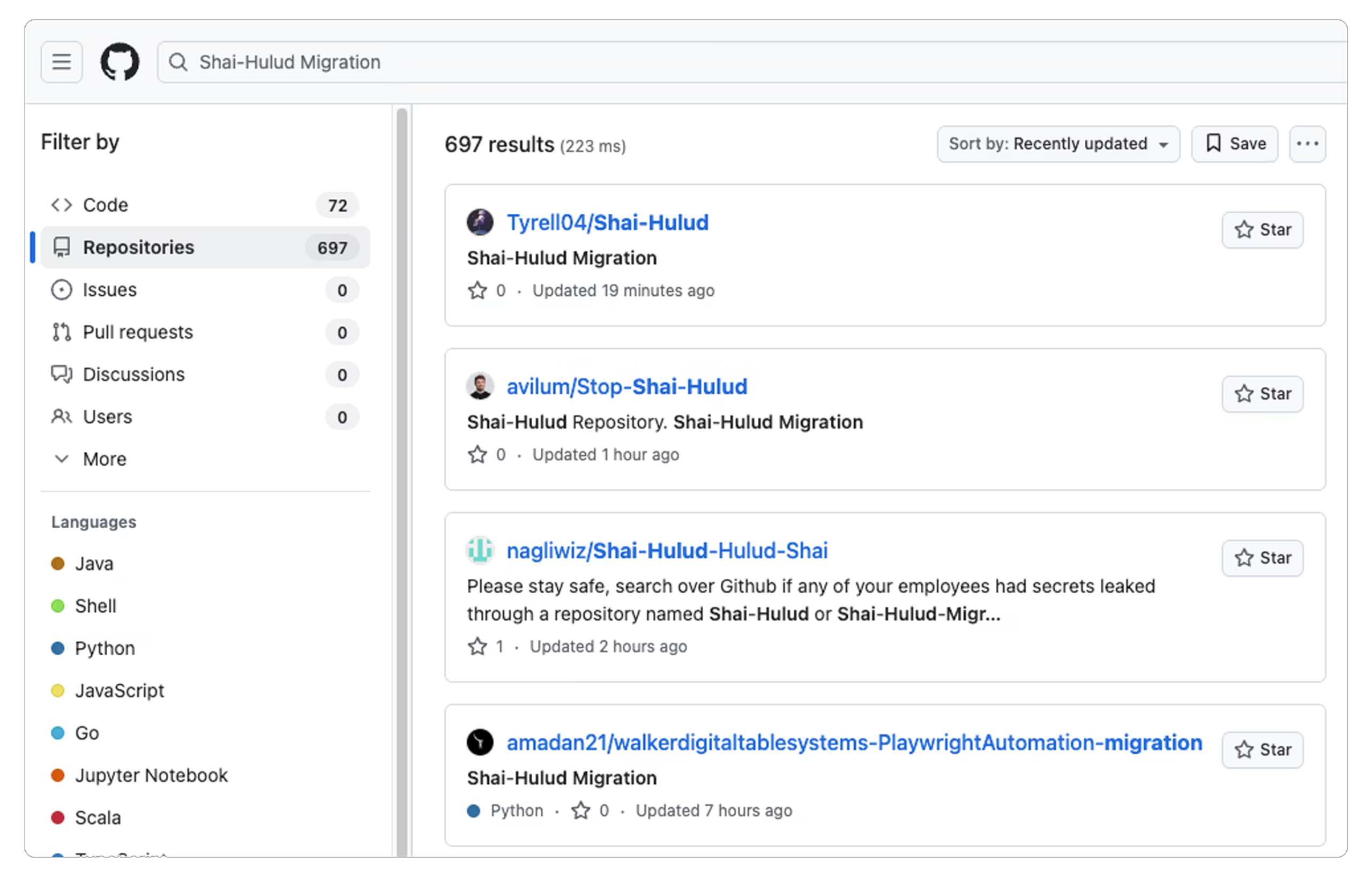The Reversing Labs group has identified a self-replicating malware which utilises stolen tokens, it automatically infects and republishes other packages under the maintainer’s control, spreading exponentially across the ecosystem. The attack primarily focuses Linux and macOS environments, and some variants even use tools like TruffleHog for deeper credential scanning while establishing persistence via malicious GitHub Actions workflows.
How the worm operates
The malware holds a workflow file named shai-hulud.yaml, a reference to the sandworms in dune franchise, indicating the name while though not unique was kept deliberately. The Initial Infection starts when a developer unsuspectingly installs a malicious npm package. These packages were named to impersonate legitimate packages from CrowdStrike, a well-known cybersecurity company, making them seem trustworthy. The Payload Execution takes place when the developer installs the package (using npm install), npm’s package manager can automatically run scripts defined in the package (e.g., a postinstall script).
The attacker placed their malicious code in this script, so it runs immediately on the developer’s machine. The malicious script’s first job is to download and run TruffleHog. This is a legitimate open-source tool designed to find accidentally leaked secrets (like API keys and private credentials) in code repositories. The attacker turned this security tool into a weapon, using it to automatically scan the victim’s computer and code for any valuable secrets. using a stolen GitHub token, the malware injects a malicious GitHub Actions workflow, shai-hulud.yaml, into the victim’s repositories.
This creates a persistent backdoor, allowing the attack to re-execute on future code pushes, continuously steal new credentials, and use any discovered npm publishing rights to infect more packages, enabling the worm to spread. This entire process was meticulously refined over several versions, as the attacker evolved the malware from a noisy reconnaissance tool into a stealthy and efficient weapon. Later versions removed direct filesystem manipulation in Favor of operating purely through API calls and workflow injection, a technique that makes the attack significantly harder to detect with traditional monitoring tools and demonstrates the maker’s deep understanding of modern developer ecosystems. In short, the attack cleverly uses the trusted npm ecosystem to get a foothold, repurposes a legitimate security tool for malicious ends, and uses GitHub’s own automation features to maintain access and exfiltrate data.

Figure 0.1 nearly 700 public repositories titled “Shai-Hulud Migration” appeared on GitHub which were then taken down – Socket
Aftermath
After the Shai-Hulud worm was identified, GitHub took immediate steps to fix the problem and make sure it doesn’t happen again. The intent was to add stronger security checks for anyone who uploads code. For developers working on their own computers, they’ll now need to use a second security step (like a code from their phone) to prove it’s really them. Also, the special “keys” that grant permission to upload code will be less powerful and will expire much more quickly. That way, if a key is ever stolen, it can’t be used for very long or to do much damage. GitHub is also creating a safer way for automated “robot helpers” to publish code. Instead of giving them a permanent master key that could be stolen, these systems will use a new, more secure handshake method. To make all of this happen, older and weaker security options are being phased out. The goal is to make the whole system safe by default, so everyone can trust the code they use.
Advisories
Cybersecurity and Infrastructure Security Agency (CISA) had issued an advisory. To mitigate the “Shai-Hulud” npm supply chain compromise, CISA recommends a multi-faceted approach. Organizations should begin by addressing their dependencies, which involves conducting a thorough review to identify any compromised packages and pinning all npm package versions to known, safe releases to prevent malicious updates. Concurrently, it is critical to enforce strong credential hygiene by immediately rotating all developer credentials, particularly GitHub Personal Access Tokens and cloud service API keys and mandating the use of phishing-resistant multifactor authentication. Proactive security measures also include actively monitoring for anomalous network behaviour that could signal a breach. Finally, CISA advises hardening GitHub security by removing unnecessary applications, auditing all webhooks for malicious activity, enabling branch protection rules to safeguard code, and activating secret scanning to detect any exposed credentials within repositories.
Conclusion
Analysing the impact of the Shai-Hulud worm through the defence lens reveals national security implications. Government agencies and defence contractors, like their commercial counterparts, increasingly rely on open-source software to accelerate development cycles for everything from internal administrative tools to sophisticated command-and-control interfaces. In this context, an attack like Shai-Hulud becomes a direct vector for nation-state aggression. A compromised developer account at a defence contractor could trigger a cascading failure. The worm’s payload could exfiltrate credentials granting access to secure cloud environments or classified data repositories. More alarmingly, the mechanism used to inject bundle.js could be repurposed to introduce subtle, dormant backdoors or logic bombs into critical defence systems, creating opportunities for sabotage. The worm’s unique feature of making private repositories public would be devastating; the exposure of proprietary source code for a weapons system, military drones, or cryptographic standard would represent a severe breach of security. Therefore, the Shai-Hulud attack serves as a stark warning that the software supply chain is a critical battleground, and ensuring its integrity is a national security imperative.
Consequently, the defence sector’s response to this evolving threat landscape must be correspondingly robust and systematic, moving beyond conventional cybersecurity measures. A critical strategic shift involves the rigorous implementation of zero-trust architecture throughout the software development lifecycle, where no component whether developed in-house or sourced from the open-source community is trusted as a rule.
This necessitates the mandatory adoption and continuous monitoring of Software Bills of Materials (SBOMs) for every application, providing a complete inventory of dependencies that can be cross-referenced against real-time threat intelligence. Furthermore, defence agencies and their contractors must establish and enforce the use of internal, air-gapped, or privately hosted package registries. In such a model, open-source packages are not pulled directly from public repositories. Instead, they are subjected to stringent vetting including static and dynamic analysis, malware scanning, and manual review before being approved and mirrored to the internal registry. This “walled garden” approach would have effectively neutralized the Shai-Hulud worm’s propagation mechanism, as compromised packages would have been flagged and blocked long before a developer could install them. In this way, the software supply chain can be treated with the same operational security and scrutiny applied to physical supply chains.













